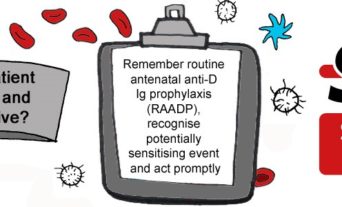Post-partum haemorrhage (PPH) remains the leading cause of maternal deaths in individual countries in Africa and collectively on the continent.1,2 Accounts of maternal deaths from many traditional African societies have stories of how women performed rites to ensure safe delivery of their babies and to signify their deliverance when they were so close to death.3
High infant mortality and a lack of modern contraceptives combined with overall low-income levels led to women having high parities, resulting in raised maternal mortality and subsequently low life expectancy at birth in the 1950s. Life at birth rose from 36.7 years in the 1950s to 48.4 years by 2000–2005 in many sub-Saharan African (SSA) countries.4−6
For almost all SSA countries, the post-independence era up to the early 1990s was characterised by very high maternal mortality ratios (MMR), about 1,000 or more per 100,000 livebirths.
The pro-natalist view of many societies in Africa, largely fuelled by high neonatal and infant mortalities, encouraged women to have more children with the hope of at least some surviving into adulthood. Closely accompanying the high parity were obstetric complications of ruptured uterus, retained placenta and excessive bleeding post-delivery.
Anaemia in pregnancy increases the risk of mortality when PPH occurs; anaemia is prevalent in both non-pregnant and pregnant women in most African countries. Correction of anaemia in these populations should therefore be part of the strategy in preventing deaths from PPH.
Access to modern health care during the colonial era of many African countries was limited to a small segment of the population and post-independence, expanding access has been slow. Therefore, cultural values, limited skill in the management of delivery complications (especially surgical ones) and low socioeconomic development combined to give high mortality rates of which PPH has always been the leading cause − about 60,000 of the 201,000 maternal deaths in Africa in 2015.7
Reducing the maternal mortality ratio
A review of the literature of western medicine shows how key developments have resulted in a significant reduction in maternal mortality including safe anaesthesia, blood transfusion, surgery (especially caesarean section and safe abortion) and antibiotics at the closing stages of the World War II.8
For almost all SSA countries, the post-independence era up to the early 1990s was characterised by very high maternal mortality ratios (MMR), about 1,000 or more per 100,000 livebirths. The leading causes of direct maternal mortality are PPH, pre-eclampsia/eclampsia, sepsis (post-abortion or post-partum) and obstructed labour.
The UN-led Millennium Development Goals brought the urgent need to address developmental challenges into sharp focus and goal 5 aimed to reduce maternal deaths by three-quarters over 25 years using the 1990 figures as the base.9 Although most African countries were unable to achieve goal 5, some progress was made in almost all countries. By 2015, the regional MMR was estimated to be 542 per 100,000 livebirths − a 44% reduction. The annual percentage reduction between 1990 and 2015 was 2.3% for the African region, making it the region with the lowest achieved gains.7,10
Making progress
The modest progress that many African countries have made in bringing down the MMR over the last 30 years or so is mainly a result of greater access to maternity care and increased use of modern contraceptives. Access to maternity care has improved the management of the top two causes of maternal deaths, PPH and eclampsia. This has been through the use of oxytocics in active management of the third stage of labour (AMSTL) to prevent haemorrhage, and anti-convulsants to prevent eclampsia. Significantly, maternal deaths have been averted by the use of contraception, helping to reduce the number of pregnancies.
Availability of care
The development of signal functions and other tools in emergency obstetric and neonatal care (EmONC) highlighted the physical infrastructure and healthcare workforce that governments must put in place to prevent maternal deaths.11
Travelling long distances to access maternity care is a limiting factor and in cases of primary PPH, it becomes a critical determinant in the outcome. Wong and colleagues reported that spatial separation between women and the delivery facilities in low-resource settings needs further development, and lack of geographic access impedes use.12 Scenarios like this can promote home delivery with its attendant dangers. The number of countries identified in this systematic review and metanalysis were limited because of lack of data from most African countries.
The role of birth attendants
Reducing maternal death from PPH requires the availability of skilled birth attendants (SBA) and having sufficient midwife numbers is key to achieving this reduction. The presence of skilled personnel in intrapartum and post-partum care (where over 98% of maternal mortalities occur) cannot be overemphasised.
Competent labour management to prevent prolonged labour, practise of AMSTL and early recognition of excessive blood loss and prompt intervention are collectively important in the prevention of haemorrhage. The pooled prevalence of SBA in the 12 East African countries was 67.2%, ranging from a low of 11.9% in Tanzania to 90.7% in Rwanda.13 Similar patterns can be found in other regions of SSA.
The midwife ratio to population has improved significantly over the last two decades.14 Some countries, for example Ghana, have introduced direct entry into midwifery schools instead of the previous system of completing three years of nursing training and practicing for a few years before entry into midwifery training.
Accompanying an increase in the availability of midwives is an improvement in doctor-patient ratios. In 2003, Ghana started its own postgraduate medical college, and the absolute numbers of doctors has increased from around 2,000 to the current number of 8,957, giving a ratio of 1 to 3,350.15 Distribution is however skewed in favour of cities like Accra and Kumasi. Similar trends are common in many SSA countries.
The use of contraceptives
Contraception uptake has increased in many SSA countries and contraception alone is known to avert deaths by preventing pregnancies. Unplanned or unwanted pregnancies are high in SSA countries and unsafe abortions can end in sepsis, while carrying the pregnancy to delivery can lead to PPH. Nearly a half of all pregnancies are unplanned or mis-timed.16 Saifuddin and colleagues showed that over 88,227 maternal deaths were averted in 2015 and 31.9% of these averted maternal deaths were attributed to contraceptive use.10
The Family Planning 2020 initiative is a global effort to ensure an additional 120 million women have access to contraceptives and progress in African countries has been satisfactory. The countries involved (Nigeria, Ghana, Burkina Faso, DR Congo, Uganda and Ethiopia) are making fair progress, with Ghana having the highest annual percentage point increase.17 If progress in meeting this unmet need is sustained into the next few decades, the proportion of deaths averted by contraception will not only be maintained, but increase further.
The way forward
PPH leading to maternal death is still common and the leading cause of maternal death (about 60,000 out of 201,000 maternal deaths in 2015).7 To reduce PPH and the resulting maternal deaths, health facilities and skilled personnel must be available close to communities so labour and its complications can be appropriately managed. This includes basic and comprehensive EmONC facilities to ensure women with PPH can receive the care they require as quickly as possible. Access to comprehensive EmONC facilities (for surgery and blood transfusion) within reasonable distances is vital to address PPH and other obstetric emergencies.
EmONC assessments show significant gaps in both basic and comprehensive facilities in many countries.18,19 The strategies that brought the 44% reduction in regional MMR during 1990 and 2015 must be sustained and expanded within the Sustainable Development Goals framework. However, this requires major investments in the health sector by both public and private sources and the efficient use of such resources.
Maintaining the appropriate storage temperature for oxytocics is challenging and an efficient cold supply chain is needed with constant monitoring. The leading cause of PPH, uterine atony, can be controlled through the use of oxytocics, however, poorly stored oxytocics are ineffective in achieving uterine tonus.20
Increasing the number of trainee midwives should be a priority to provide adequate distribution across countries and ensure midwives of retirement age are replaced.
The strategic placement of safe blood services is important in reducing MMR from PPH. Rwanda and Ghana use drones to circumvent the challenge of transporting blood and other products to hard-to-reach rural communities. This technology must be expanded, and sustainability frameworks established to ensure long-term success. However, the use of drones should augment the existing health infrastructure (EmONC facilities) and not be seen as a replacement.
Increasing the number of trainee midwives should be a priority to provide adequate distribution across countries and ensure midwives of retirement age are replaced. Curricular reviews are needed to enhance the skill set and practical experience gained during training. The training of obstetricians and the deployment of obstetricians, midwives and anaesthetists to under-served areas is more challenging. However, these challenges are surmountable by developing policies to attract these personnel to these areas, such as mandatory intern rotations to such communities and inducements.
Conclusion
Over the last 150 years, Africa has transitioned from home deliveries with high MMR to increasing institutional deliveries with availability of surgical and transfusion services. The expansion in access to maternity services must be continued to further reduce maternity mortality and the occurrence of PPH. Initiatives to increase access to contraceptives need to expand and accelerate to reduce maternal mortality further.




